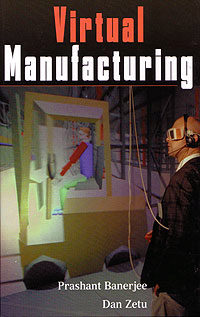Virtual Manufacturing
January 1st, 2001
Categories: Applications, Devices, Education, Human Factors, Industrial VR, Tele-Immersion, Visualization

Authors
Banerjee, P., Zetu, D.About
Excerpt from Virtual Manufacturing
With the advent of high-resolution graphics, high-speed computing, and user interaction devices, virtual reality (VR) has emerged as a major new technology in recent years. An important new concept introduced by many VR systems is immersion, which refers to the feeling of complete immersion in a three-dimensional computer-generated environment by means of user-centered perspective achieved through tracking the user. This is a huge step forward compared to classical modeling and CAD / CAM packages, which inherently impose major limitations on intuitive user interaction. VR technology is currently used in a broad range of applications, the best known being flight simulators, walkthroughs, video games, and medicine (virtual surgery). From a manufacturing standpoint, some of the attractive applications include training, collaborative product and process design, facility monitoring, and management. Moreover, recent advances in broadband networks are also opening up new applications for telecollaborative virtual environments in these areas.
In this book we have chosen to cover certain areas which we believe to have a potentially significant impact on virtual manufacturing. This is still an evolving list and includes areas such as facility layout and work-cell management, real-time exact collision detection, motion modeling, avatar modeling, and virtual-real environment interaction in training, based on our years of experience in this field. In addition to these areas, the book explores some connections between VR and computer vision (especially camera self-calibration and stereo vision) in the context of depth recovery in virtual manufacturing. Some of the automation techniques resulting from these concepts can potentially reduce a lot of time and boredom for users involved in manually creating CAD-based virtual environments. Lately, with the emergence of complementary areas of VR such as augmented reality (AR), one can address crucial problems of registration between virtual and real worlds.
Chapter 1 provides an introduction to virtual manufacturing in the context of the book, provides illustrative applications and highlights research issues. In Chapters 2 to 5 we present some basic principles of computer graphics, virtual reality, depth extraction, and shape reconstruction, respectively. Numerous applications in virtual manufacturing are presented in Chapters 6 to 10. These applications have been developed based on work carried out at the Industrial Virtual Reality Institute at the University of Illinois at Chicago. They include the thesis work of A. Banerjee, R. Tesic, D. Zetu, and V. Giallorenzo. The contributions of the following individuals are also gratefully acknowledged: A. Akgunduz, C. Luciano, D. Thompson, P. Schneider, S. Anantharaman, and K. Gierach. The book is meant as an introduction to the basic concepts of virtual manufacturing from a VR perspective, not only for engineering students, but also for professionals interested in developing applications in this field. Last, but not the least, we would also like to thank T. DeFanti, D. Sandin, M. Brown, J. Leigh, D. Pape. D. Plepys, G. Dawe, A. Verlo, and numerous other members of the Electronic Visualization Laboratory at the University of Illinois at Chicago for providing constant encouragement and support over a number of years to make some of the work possible.
- From Virtual Manufacturing, by Prashant Banerjee, et al. © March 9, 2001 , Wiley used by permission.
Citation
Banerjee, P., Zetu, D., Virtual Manufacturing, John Wiley, New York, 2001 (ISBN: 0-471-35443-0), January 1st, 2001.